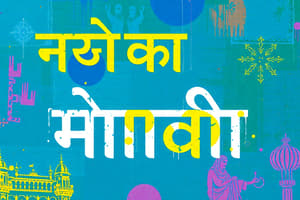Podcast
Questions and Answers
What is a key distinction between the standardized forms of Hindi and Urdu?
What is a key distinction between the standardized forms of Hindi and Urdu?
- Hindi uses the Perso-Arabic script, while Urdu uses the Devanagari script.
- Hindi literature primarily focuses on secular themes, whereas Urdu literature is largely religious.
- Hindi relies heavily on Sanskrit for vocabulary, while Urdu draws from Persian and Arabic. (correct)
- Hindi employs a simpler system of verbal morphology compared to Urdu.
How has Hindi cinema, particularly Bollywood, contributed to the Hindi language?
How has Hindi cinema, particularly Bollywood, contributed to the Hindi language?
- Bollywood films primarily use English, thereby reducing the popularity of Hindi.
- Bollywood has had minimal impact on the popularity of Hindi, as it caters mainly to niche audiences.
- Bollywood exclusively focuses on historical dramas, thus preserving archaic forms of Hindi.
- Bollywood films have promoted Hindi language and culture extensively both in India and internationally. (correct)
Why might the promotion of Hindi face resistance in some regions of India?
Why might the promotion of Hindi face resistance in some regions of India?
- Due to the preference for Urdu as a national language in certain regions.
- Because Sanskrit is seen as a more appropriate national language.
- Due to India's linguistic diversity and concerns about imposing Hindi on non-Hindi speaking populations. (correct)
- Because Hindi is not considered an official language by the Indian government.
Which aspect is essential for effectively learning to read and write in Hindi?
Which aspect is essential for effectively learning to read and write in Hindi?
What is the relationship between Hindi and English in urban areas of India, and what challenge does this present?
What is the relationship between Hindi and English in urban areas of India, and what challenge does this present?
Which historical period saw significant development of Hindustani, a language influenced by both Hindi and Persian?
Which historical period saw significant development of Hindustani, a language influenced by both Hindi and Persian?
Hindi grammar utilizes postpositions rather than prepositions. How does this affect the structure of phrases?
Hindi grammar utilizes postpositions rather than prepositions. How does this affect the structure of phrases?
What characteristic of the Devanagari script allows for modification of the inherent vowel sound in a consonant?
What characteristic of the Devanagari script allows for modification of the inherent vowel sound in a consonant?
Which of the following language features of Hindi is a characteristic of Indo-European languages?
Which of the following language features of Hindi is a characteristic of Indo-European languages?
A linguist is studying a regional variation of Hindi and notes significant differences in vocabulary and pronunciation compared to Standard Hindi. Which of the following is the linguist most likely observing?
A linguist is studying a regional variation of Hindi and notes significant differences in vocabulary and pronunciation compared to Standard Hindi. Which of the following is the linguist most likely observing?
How does the varying degree of Sanskritization affect communication in Hindi?
How does the varying degree of Sanskritization affect communication in Hindi?
What is the functional use of the 'inherent vowel' concept in Devanagari script?
What is the functional use of the 'inherent vowel' concept in Devanagari script?
Hindi is closely related to Urdu, Punjabi, Bengali and Marathi. Which linguistic grouping do these languages belong to?
Hindi is closely related to Urdu, Punjabi, Bengali and Marathi. Which linguistic grouping do these languages belong to?
Flashcards
Hindi Verbal Morphology
Hindi Verbal Morphology
A system using auxiliary and compound verbs.
Early Hindi Literature
Early Hindi Literature
Early works include poems focused on religion.
Bhakti Poetry
Bhakti Poetry
Poems expressing devotion to deities.
Hindustani
Hindustani
Signup and view all the flashcards
Bollywood
Bollywood
Signup and view all the flashcards
What is Hindi?
What is Hindi?
Signup and view all the flashcards
Hindi's origin
Hindi's origin
Signup and view all the flashcards
Standard Hindi
Standard Hindi
Signup and view all the flashcards
Hindi's official status
Hindi's official status
Signup and view all the flashcards
Hindi's linguistic family
Hindi's linguistic family
Signup and view all the flashcards
Devanagari script
Devanagari script
Signup and view all the flashcards
Hindi's Vocabulary Influences
Hindi's Vocabulary Influences
Signup and view all the flashcards
Dialects of Hindi
Dialects of Hindi
Signup and view all the flashcards
Study Notes
- Hindi is an Indo-Aryan language spoken chiefly in India.
History and Origin
- Hindi evolved from early forms of Prakrit through Shauraseni Apabhramsa around the 7th-10th centuries AD.
- It is a descendant of Sanskrit.
- The standardized form of Hindi is based on the Khariboli dialect of the Delhi region.
- The Delhi Sultanate and Mughal Empire helped in the development of Hindustani, a language with Hindi and Persian influences.
Official Status
- Hindi is one of the two official languages of the Union government of India; the other being English.
- It is an official language in nine states and three union territories of India: Uttar Pradesh, Bihar, Jharkhand, Uttarakhand, Madhya Pradesh, Haryana, Himachal Pradesh, Chhattisgarh, Rajasthan, Delhi, Andaman and Nicobar Islands, and Chandigarh.
Linguistic Features
- Hindi is an Indo-European language, belonging to the Indo-Aryan branch.
- It is closely related to other Indo-Aryan languages such as Urdu, Punjabi, Bengali, and Marathi.
- Hindi exhibits a Subject-Object-Verb (SOV) word order.
- It is a morphologically rich language with extensive inflection.
- Hindi uses postpositions instead of prepositions.
- The language has a relatively large inventory of sounds, including aspirated and retroflex consonants.
Devanagari Script
- Hindi is written in the Devanagari script.
- Devanagari is an abugida, a writing system where consonant-vowel sequences are written as a unit.
- Each consonant has an inherent vowel "a," which can be changed or suppressed by adding vowel signs.
- Devanagari is written from left to right.
- The script is also used for other languages like Sanskrit, Marathi, and Nepali.
Vocabulary
- The vocabulary of Hindi is heavily influenced by Sanskrit and Prakrit.
- It also contains loanwords from Persian, Arabic, and English.
- The degree of Sanskritization in Hindi can vary, with some speakers using more Sanskrit-derived terms and others using simpler, more colloquial vocabulary.
Dialects
- Hindi has several dialects and regional variations.
- These dialects can differ significantly in vocabulary, grammar, and pronunciation.
- Some of the major dialects include Khariboli, Braj Bhasha, Awadhi, and Bagheli.
- Standard Hindi is based on the Khariboli dialect.
Grammatical Structure
- Hindi grammar includes nouns, pronouns, adjectives, verbs, adverbs, and particles.
- Nouns are inflected for gender (masculine and feminine), number (singular and plural), and case.
- Verbs are conjugated for tense, aspect, mood, gender, and number.
- Hindi has a complex system of verbal morphology, including auxiliary verbs and compound verbs.
- Agreement between verbs and subjects is important in Hindi grammar.
Literature
- Hindi literature has a rich history spanning several centuries.
- Early Hindi literature includes religious and devotional poetry.
- Medieval Hindi literature saw the rise of Bhakti poetry, with prominent poets.
- Modern Hindi literature includes novels, short stories, plays, and essays.
Influence of Urdu
- Hindi and Urdu are considered mutually intelligible in colloquial form, often referred to as Hindustani.
- The primary difference between Hindi and Urdu lies in their standardized forms and vocabulary; Hindi draws heavily on Sanskrit, while Urdu draws on Persian and Arabic.
- Urdu is written in the Perso-Arabic script, while Hindi is written in the Devanagari script.
Hindi Cinema
- Hindi cinema, also known as Bollywood, is a major film industry based in Mumbai.
- Bollywood films are predominantly in Hindi and attract a large audience in India and abroad.
- Hindi cinema has played a significant role in popularizing the Hindi language and culture.
Learning Hindi
- Hindi is a popular language to learn for people interested in Indian culture, religion, and history.
- Many universities and language schools offer Hindi courses.
- Online resources and language learning apps are also available.
- Learning the Devanagari script is essential for reading and writing Hindi.
Challenges
- Despite its widespread use, Hindi faces challenges such as linguistic diversity in India.
- Promotion of Hindi has sometimes been met with resistance in non-Hindi speaking regions.
- Code-switching and code-mixing with English are common, particularly in urban areas.
- Maintaining the purity of the language against the influence of other languages remains a concern for some linguists and scholars.
Studying That Suits You
Use AI to generate personalized quizzes and flashcards to suit your learning preferences.
Description
Hindi is an Indo-Aryan language primarily spoken in India, evolving from Prakrit through Shauraseni Apabhramsa. It is derived from Sanskrit, with its standardized form based on the Khariboli dialect of Delhi. Hindi is one of the two official languages of the Union government of India.




